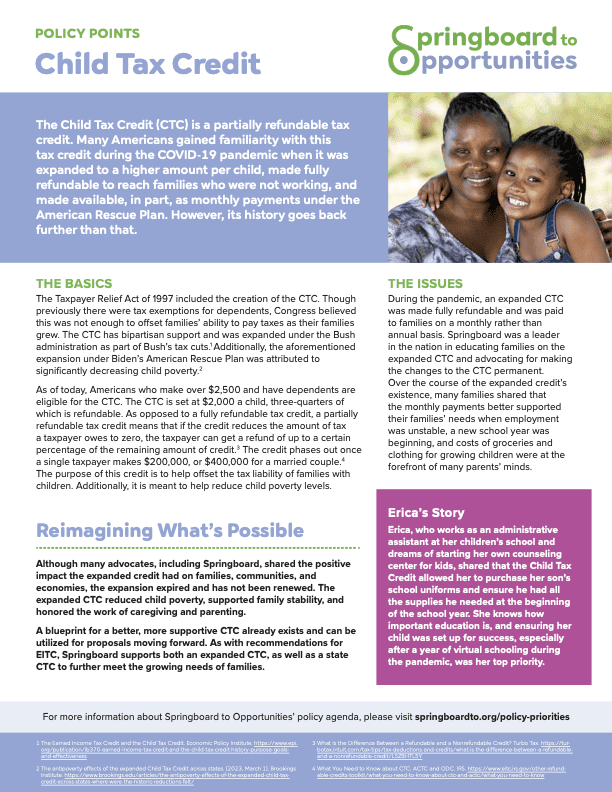POLICY POINTS
Child Tax Credit
The Child Tax Credit (CTC) is a partially refundable tax credit. Many Americans gained familiarity with this tax credit during the COVID-19 pandemic when it was expanded to a higher amount per child, made fully refundable to reach families who were not working, and made available, in part, as monthly payments under the American Rescue Plan. However, its history goes back further than that.
THE BASICS
The Taxpayer Relief Act of 1997 included the creation of the CTC. Though previously there were tax exemptions for dependents, Congress believed this was not enough to offset families’ ability to pay taxes as their families grew. The CTC has bipartisan support and was expanded under the Bush administration as part of Bush’s tax cuts.1 Additionally, the aforementioned expansion under Biden’s American Rescue Plan was attributed to significantly decreasing child poverty.2
As of today, Americans who make over $2,500 and have dependents are eligible for the CTC. The CTC is set at $2,000 a child, three-quarters of which is refundable. As opposed to a fully refundable tax credit, a partially refundable tax credit means that if the credit reduces the amount of tax a taxpayer owes to zero, the taxpayer can get a refund of up to a certain percentage of the remaining amount of credit.3 The credit phases out once a single taxpayer makes $200,000, or $400,000 for a married couple.4 The purpose of this credit is to help offset the tax liability of families with children. Additionally, it is meant to help reduce child poverty levels.
1 The Earned Income Tax Credit and the Child Tax Credit. Economic Policy Institute. https://www.epi.org/publication/ib370-earned-income-tax-credit-and-the-child-tax-credit-history-purpose-goals-and-effectiveness/
2 The antipoverty effects of the expanded Child Tax Credit across states. (2023, March 1). Brookings Institute. https://www.brookings.edu/articles/the-antipoverty-effects-of-the-expanded-child-tax-credit-across-states-where-were-the-historic-reductions-felt/
3 What Is the Difference Between a Refundable and a Nonrefundable Credit? Turbo Tax. https://turbotax.intuit.com/tax-tips/tax-deductions-and-credits/what-is-the-difference-between-a-refundable-and-a-nonrefundable-credit/L5ZBHTL5Y
4 What You Need to Know about CTC, ACTC and ODC. IRS. https://www.eitc.irs.gov/other-refundable-credits-toolkit/what-you-need-to-know-about-ctc-and-actc/what-you-need-to-know
THE ISSUES
During the pandemic, an expanded CTC was made fully refundable and was paid to families on a monthly rather than annual basis. Springboard was a leader in the nation in educating families on the expanded CTC and advocating for making the changes to the CTC permanent. Over the course of the expanded credit’s existence, many families shared that the monthly payments better supported their families’ needs when employment was unstable, a new school year was beginning, and costs of groceries and clothing for growing children were at the forefront of many parents’ minds.

Erica’s Story
Erica, who works as an administrative assistant at her children’s school and dreams of starting her own counseling center for kids, shared that the Child Tax Credit allowed her to purchase her son’s school uniforms and ensure he had all the supplies he needed at the beginning of the school year. She knows how important education is, and ensuring her child was set up for success, especially after a year of virtual schooling during the pandemic, was her top priority.

